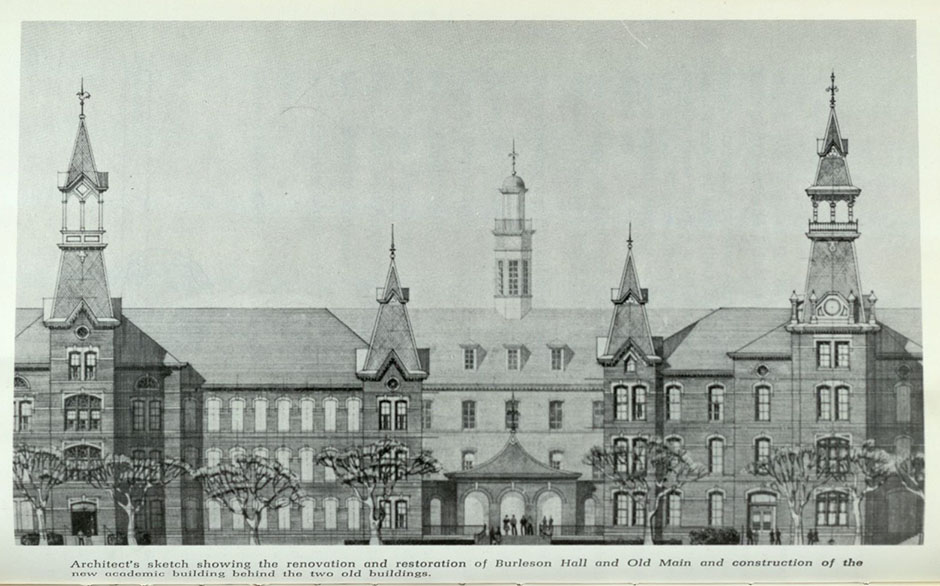Texas has changed quite a bit over the years, as is readily seen in our vast photograph and postcard collections. To help bring some of those changes to life, we’ve created a “Texas over Time” series of GIFs that will illustrate the construction and renovations of buildings, changing aerial views, and more. Our collections are especially strong on Waco and Baylor images, but look for some views beyond the Heart of Texas, too.
 Our readers may remember that we did a GIF of Waco’s Austin Avenue awhile back, looking at City Hall. Now, we look the other direction! A few facts about the buildings/businesses you see in this GIF…
Our readers may remember that we did a GIF of Waco’s Austin Avenue awhile back, looking at City Hall. Now, we look the other direction! A few facts about the buildings/businesses you see in this GIF…
- ALICO Building: Construction for the Amicable (ALICO) Building began in 1910 and after a height competition with the Adolphus Hotel in Dallas, it was decided that the building would be 22-stories high. The builders, Sanguinet and Staats of Forth Worth and Roy E. Lane of Waco, wanted the building to have a structure that could sustain disaster, so a steel frame was put into place, and this was proved worthwhile after the 1953 tornado. The Texas State Historical Commission named the ALICO building a historical landmark in 1982.
- Roosevelt Hotel: Before it became the Roosevelt Hotel, local civic leader Peter McClelland built the McClelland Hotel in 1872. The property was purchased by Conrad Hilton of the international chain, Hilton Hotels and Resorts. The economic downturn of the Great Depression caused Hilton to sell the property in 1934 to local investors, where it finally became known as the Roosevelt Hotel, honoring President Franklin D. Roosevelt. The Roosevelt was one of the three buildings in the storm’s path that stood strong during the 1953 Waco tornado. Its steel frame supported the structure but for the businesses that did not survive, the owners relocated to the suburbs and the Roosevelt Hotel was forced to close in 1961. After its life as the Regis Retirement Home, local builder Mike Clark bought the building in 2004 and the space was renovated to accommodate event rentals, restaurants, and offices.
- W.P. Pipkin Drugs: One of the Southwest’s largest independently owned drugstore chains, the W.P. Pipkin Drug store was successfully run by William Pipkin and then after his death, it was run by his daughter, Pauline Pipkin Garrett. Pipkin was the first drugstore owner to hire women and in a time where opportunities for women were limited, Garrett exceeded these expectations by expanding her father’s business into a thriving enterprise throughout Waco. Pipkin Drugs had seven locations.
- Sanger Bros./Montgomery Ward: The Sanger Brothers open their shoe store on the square between Austin Avenue and Bankers’ Alley on March 4, 1873. Their store later moved between Fourth and Fifth Street on Austin Avenue. Products the store sold included “dry goods, clothing, boots, shoes, hats, caps, gents’ furnishing goods, carpets, and oil cloths,” per an ad by the Waco Daily Examiner. The business was very successful up until Sam Sanger’s death in 1919. In its final days thousands of dedicated customers were reported to show up for the last sales.
Bibliography
Kyle Baughman and Amanda Sawyer, “Amicable (ALICO) Building,” Waco History, accessed October 9, 2015, http://wacohistory.org/items/show/23.
Geoff Hunt, “Pauline Pipkin Garrett,” Waco History, accessed October 9, 2015, ffghttp://wacohistory.org/items/show/101.
Amanda Sawyer, “Sanger Brothers Department Store,” Waco History, accessed October 9, 2015, http://wacohistory.org/items/show/85.
Amanda Sawyer, “Roosevelt Hotel,” Waco History, accessed November 4, 2015, http://wacohistory.org/items/show/41.
GIF and factoids by Haley Rodriguez, archives student assistant. See these and other images of Austin Avenue in our Flickr set.














